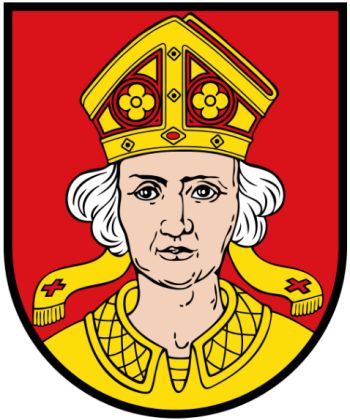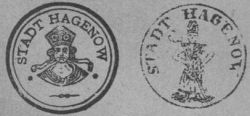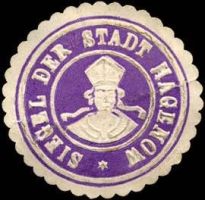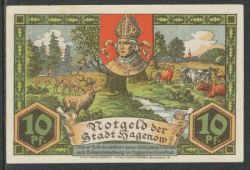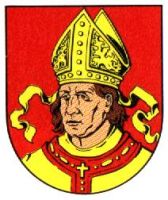Hagenow: Difference between revisions
Knorrepoes (talk | contribs) m (added Category:Granted 1940 using HotCat) |
Knorrepoes (talk | contribs) m (Text replacement - "===Image Gallery===" to "===Image gallery===") |
||
| (19 intermediate revisions by the same user not shown) | |||
| Line 1: | Line 1: | ||
{ | {| class="wikitable" | ||
|- style="vertical-align:top;" | |||
|[[File:hagenow1.jpg|center|350 px|alt=Wappen von {{PAGENAME}}/Arms (crest) of {{PAGENAME}}]] | |||
| | |||
<center>''' {{uc:{{PAGENAME}}}} '''</center><br> | |||
'''Country''' : Germany [[File:germany.jpg|60 px|right]]<br><br><br> | |||
'''State''' : [[Mecklenburg-Vorpommern]][[File:Mecklenv1.jpg|60 px|right]]<br><br><br> | |||
'''District (Kreis)''' : [[Ludwigslust-Parchim]] (until 2011 [[Ludwigslust (kreis)|Ludwigslust]])[[File:ludwparchim.kreis.jpg|60 px|right]]<br><br><br> | |||
|} | |||
{| class="wikitable" | |||
|+Official blazon | |||
|- | |||
|'''German''' | |||
| In Rot das Brustbild eines hersehenden Bischofs mit natürlicher Gesichtsfarbe, silbernem Haar, rot verzierter goldener Bischofsmütze und goldenem Gewand. | |||
|- | |||
|'''English''' | |||
| blazon wanted | |||
|} | |||
===Origin/meaning=== | ===Origin/meaning=== | ||
| Line 16: | Line 25: | ||
Hagenow was first mentioned in a document from round 1190, and was first mentioned as a city in a charter from 1420. In 1370 it was still mentioned as village. However, as a city it was still subject to Schwerin, only in 1754 it became an independent city. | Hagenow was first mentioned in a document from round 1190, and was first mentioned as a city in a charter from 1420. In 1370 it was still mentioned as village. However, as a city it was still subject to Schwerin, only in 1754 it became an independent city. | ||
The oldest known seal is known from a charter from 1420 and already shows the bust of a bishop, see below. The seal states S(igillum) Op(p)idi Haghenowe, indicating an older origin (oppidum=village). The bust most likely represents Saint Denis of Paris, the patron saint of the local church at the time. | The oldest known seal is known from a charter from 1420 and already shows the bust of a bishop, see below. The seal states S(igillum) Op(p)idi Haghenowe, indicating an older origin (oppidum=village/town). The bust most likely represents Saint Denis of Paris, the patron saint of the local church at the time. The bust is behind a fence, which can be explained in two ways; the name Hagenow is derived from Hage, meaning a fence, or it refers to the fact that the village was protected by fences rather than walls at the time. | ||
The composition of the seal was officially adopted as arms in 1858, but was used already earlier by the town. The saint was officially described as a bishop, not as Saint Denis. The colours were chosen arbitrarily in 1858. The actual design of the head has changed during the years based on the preference of the artist. | The composition of the seal was officially adopted as arms in 1858, but was used already earlier by the town. The saint was officially described as a bishop, not as Saint Denis. The colours were chosen arbitrarily in 1858. The actual design of the head has changed during the years based on the preference of the artist. | ||
| Line 24: | Line 33: | ||
These arms were used only until 1945 when the historical arms were restored. Uncharacteristically, the arms with the saint were continued during the DDR (saints were not seen as appropriate symbols at the time) and officially redesigned in 1996. | These arms were used only until 1945 when the historical arms were restored. Uncharacteristically, the arms with the saint were continued during the DDR (saints were not seen as appropriate symbols at the time) and officially redesigned in 1996. | ||
===Image gallery=== | |||
<gallery widths=250px heights=200px perrow=0> | |||
File:hagenowz2.jpg|alt=Wappen von Hagenow/Arms (crest) of Hagenow|Seal from 1420 | |||
File:Hagenow1892.jpg|alt=Wappen von Hagenow/Arms (crest) of Hagenow|The municipal stamp shown in 1892 | |||
File:hagenowz1.jpg|alt=Wappen von Hagenow/Arms (crest) of Hagenow|Seal from around 1900 | |||
File:hagenow2.jpg|alt=Wappen von Hagenow/Arms (crest) of Hagenow|Local emergency money from 1920 | |||
File:hagenow.hagd.jpg|alt=Wappen von Hagenow/Arms (crest) of Hagenow|The arms by [[Otto Hupp|Hupp]] in the [[Kaffee Hag albums]] +/- 1925 | |||
File:hagenow1940.jpg|alt=Wappen von Hagenow/Arms (crest) of Hagenow|The arms from 1940-1945 | |||
File:hagenow.jpg|alt=Wappen von Hagenow/Arms (crest) of Hagenow|The arms during DDR times | |||
File:Hagenowp.jpg|alt=Wappen von Hagenow/Arms (crest) of Hagenow|Postal cancellation | |||
</gallery> | |||
| | |||
[[Civic Heraldry Literature - Germany|'''Literature''']]: Bensing et al., 1984; Schütt, 2002 | |||
{{de}} | |||
{{media}} | {{media}} | ||
[[Category:German Municipalities H]] | [[Category:German Municipalities H]] | ||
Revision as of 08:24, 3 September 2023
|
Country : Germany State : Mecklenburg-Vorpommern District (Kreis) : Ludwigslust-Parchim (until 2011 Ludwigslust) |
| German | In Rot das Brustbild eines hersehenden Bischofs mit natürlicher Gesichtsfarbe, silbernem Haar, rot verzierter goldener Bischofsmütze und goldenem Gewand. |
| English | blazon wanted |
Origin/meaning
The arms were officially granted on April 10, 1858.
Hagenow was first mentioned in a document from round 1190, and was first mentioned as a city in a charter from 1420. In 1370 it was still mentioned as village. However, as a city it was still subject to Schwerin, only in 1754 it became an independent city.
The oldest known seal is known from a charter from 1420 and already shows the bust of a bishop, see below. The seal states S(igillum) Op(p)idi Haghenowe, indicating an older origin (oppidum=village/town). The bust most likely represents Saint Denis of Paris, the patron saint of the local church at the time. The bust is behind a fence, which can be explained in two ways; the name Hagenow is derived from Hage, meaning a fence, or it refers to the fact that the village was protected by fences rather than walls at the time.
The composition of the seal was officially adopted as arms in 1858, but was used already earlier by the town. The saint was officially described as a bishop, not as Saint Denis. The colours were chosen arbitrarily in 1858. The actual design of the head has changed during the years based on the preference of the artist.
On September 2, 1940 the city received different arms, a silver horse on a red shield. The meaning of the horse is not known.
These arms were used only until 1945 when the historical arms were restored. Uncharacteristically, the arms with the saint were continued during the DDR (saints were not seen as appropriate symbols at the time) and officially redesigned in 1996.
Image gallery
The arms by Hupp in the Kaffee Hag albums +/- 1925
Literature: Bensing et al., 1984; Schütt, 2002
This page is part of the German heraldry portal Deutsche Wappensammlung |
Heraldry of the World |
|
German heraldry:
|
Selected collector's items from Germany:
|
Contact and Support
Partners:
Your logo here ?
Contact us
© since 1995, Heraldry of the World, Ralf Hartemink 
Index of the site
